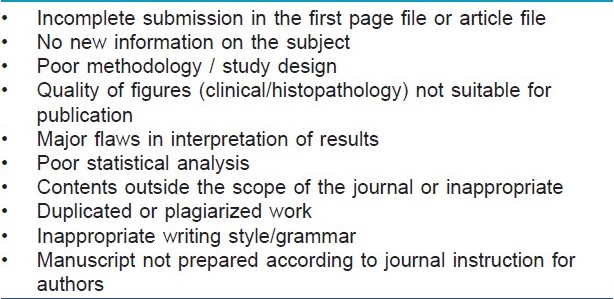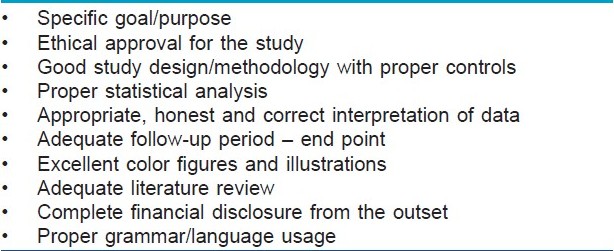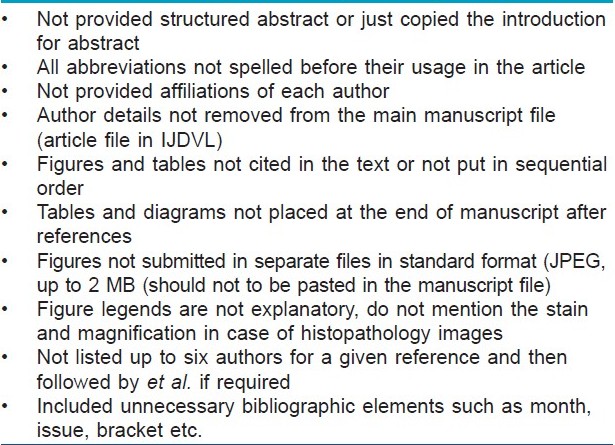Translate this page into:
Why your manuscript was rejected and how to prevent it?
Correspondence Address:
Sunil Dogra
Department of Dermatology, Venereology and Leprology, Postgraduate Institute of Medical Education and Research, Chandigarh
India
| How to cite this article: Dogra S. Why your manuscript was rejected and how to prevent it?. Indian J Dermatol Venereol Leprol 2011;77:123-127 |
A majority of manuscripts submitted to peer-reviewed journals are either rejected or require revision which may be minor or major in nature. Acceptance or rejection rates vary from journal to journal, and are dependent on a variety of factors, such as inventory of articles waiting publication, number of new submissions and constraints imposed by the size of the journal, particularly the printed version and most importantly the desired quality of articles envisioned by the editor/editorial board to improve the standard of the journal so as to attract high-quality submissions. [1]
A small minority of articles are accepted in the very first review process, while a majority are either summarily rejected with no further resubmission possible or rejected with opportunity to resubmit as they require revision/modifications. The most complete or primary rejection is when the editor or the editorial team do not consider an article to be worth referring for peer review. This editorial rejection usually happens when the subject of discussion is not supported by good-quality images, and is outside the scope of a given journal or inappropriate for that particular audience of the journal. An editorial rejection may also ensue if the contents of a manuscript are very similar to the material that has very recently been accepted by that journal or published in the recent past in the same journal or journals of similar category. [2] Another common reason for editorial rejection is that the manuscript concerned does not convey any new information or the contents are of very poor quality not permitting its publication in any form or the case report is about a disease of common occurrence. Similar situation prevails in the Indian Journal of Dermatology, Venereology and Leprology (IJDVL). In this article, common reasons for rejection of manuscripts submitted to biomedical journals are discussed with general instructions on what should be done to avoid it.
Common Reasons for Manuscript Rejection
Always follow the instructions to authors for the journal to which you are submitting your article
Each journal has its own specific instructions for authors and these should be carefully read and followed while preparing a manuscript. A small group of editors of general medical journals met informally in Vancouver (1978) to establish guidelines for the format of manuscript submission to their journals. The Vancouver Group expanded and evolved into the International Committee of Medical Journal Editors (ICMJE), which meets annually and has gradually broadened its scope. In order to minimize the variability in style or requirement between journals, "the uniform requirement for manuscript submission to biomedical journals criteria" can be found at http://www.icmje.org. The World Association of Medical Editors (WAME, www.wame.org), has also adopted the recommendations of the ICMJE. [3] It is imperative to read the ′′instructions to authors′′ for the journal of interest and to follow those instructions. Particularly, ensure the accuracy of the abstract style/format, proper headings and subheadings required for a particular type of manuscript, accuracy of the references format (e.g., for IJDVL, to put at least six authors names before et al, if there are more than six in a given reference) and quality of figures and images. Nowadays, in some of the medical journals, templates for each type of submission are available which can be helpful while preparing a manuscript. These need to be modified as per the journal′s requirement.
Check for typographical errors, spellings and grammar before submission
Manuscripts with many spelling errors and grammatical errors often make the editor and the reviewer suspicious that the entire study results might have been written in a casual way and that the authors are not sincere in their efforts or sure of what to convey. The final draft of the manuscript should have been read and carefully reviewed by all the coauthors paying particular attention to spellings, grammar, typographical errors and references before it is submitted to the journal. Such errors display a poor approach of the authors at a first glance of the manuscript and result in undue delays before it is sent for peer review. It is worthwhile to go through a hard copy of the manuscript rather than going through the manuscript on a computer screen. Writing skill is very important to prepare a good-quality manuscript in order to achieve a better possibility for publication.
Do not resubmit a manuscript without making substantive corrections as advised by the editor of another journal rejecting your manuscript
It is a policy of peer-reviewed journals to assign the manuscript for review to an expert who is active in that area. It may so happen that a manuscript is sent to the same reviewer who had recommended rejection of the paper on its prior submission to another journal giving reasons for rejection and sometimes detailed comments and suggestions which are likely to improve the manuscripts. Thus manuscript resubmitted to another journal without making necessary corrections may face immediate rejection if it is sent to the same expert for peer review. It is a good practice to disclose to the editor that this particular manuscript had been rejected elsewhere and is being submitted to the present journal with substantial changes. In many good journals, the editorial board appreciates if reason(s) for rejection by the previous journal are disclosed and the points raised by reviewers in the previous submission have been taken care of. [4]
A clear hypothesis should be mentioned in the study
One of the basic aims of scientific research is to test a new hypothesis which is generated out of old scientific evidence and the hypothesis being tested should be clearly mentioned in the introduction section of the manuscript. Title may be catchy and self explanatory but not deceptive. This helps the reader to better analyze the study design and interpret results.
Manuscript should be focused and discussion to be relevant
The aims and objectives if defined clearly would automatically guide the mind of the reviewers and readers to what to expect. Sometimes these are ignored and in the end, the whole sense may change with different conclusions drawn. Study design should be sound and discussed in detail in the methods section with relevant elaboration on statistical tests used. Often, period of study and duration of study are missing. Statement about ethical clearance for studies on human or animal subjects should be made. Results section of the manuscript should have all the information which is to be elaborated in discussion. Discussion part should be relevant to the hypothesis or index case and not related to a particular disease in general. For example, if somebody is describing a case of histoid leprosy, the focus should be histoid leprosy and there is no point in discussing prevalence, classification, treatment of leprosy in general. It is always helpful to have inputs from the senior colleagues in the department who are active in manuscript writing and familiar with publication process. Even seasoned writers often have their paper reviewed ′in house′ from colleagues to make sure that it is as flawless as possible.
You should not plagiarize other authors or yourself and do not omit pertinent references
Plagiarism is the failure to acknowledge other colleagues′ scientific work (ideas, language, or data). It may include verbatim copying of passages without citing the original contributor, rewording of ideas, paraphrasing, and even total reproduction by simply changing the name(s) of the author(s) and trying to pass the material as one′s own. Another scenario is when the author(s) have a similar paper published or in the publication process in another journal without disclosing this fact to the editor of the present journal. Sometimes, authors willfully try to get more publications out of the data derived from the same study having overlapping contents and this approach can prove to be of serious consequences. [5] Although it is generally difficult to detect plagiarism, advances in information technology are making it easier. Manuscript submission site of many journals including IJDVL now provides a plagiarism check facility for editors.
The editors, reviewers and readers generally believe in good faith that what they are reading is original work. Nonetheless, the availability of dedicated web sites designed to provide information on plagiarism ( http://www.plagiarism.org ) and softwares to detect plagiarism have made it easier for the reviewers and editorial staff of journals to detect copying ( http://www.ithenticate.com and www.turnitin.com). It is possible to make use of modern electronic search systems and electronic databases and run accepted papers through the text similarity search engine such as eTBLAST ( http://www.etblast.org ) to hunt for duplications prior to publication. [6]
Your manuscript should add new information to the existing knowledge on a given field
Manuscripts which are written aimlessly or just as a "fifth case report of a condition from India" do not attract attention of either the editor or the reader. Before you start a study in clinical research, it is useful to get statistical advice pertaining to the study design. Author(s) must calculate the number of study subjects required to achieve a particular statistical power for the study and should avoid misusing statistics. [7] For repeat studies on the same subject, the reasons to do so should be given clearly; otherwise, nobody will be interested in such a study.
Always disclose conflict of interest and source of funding, if any
Sometimes studies are well designed and statistical analysis is perfect, but it is non-disclosure that makes the editor highly suspicious about the authenticity of results. If authors have any financial interest or the study is supported or sponsored by a particular pharmaceutical company, it should be clearly stated in appropriate places. Acknowledge a person who has contributed significantly to the study but not to the extent required for authorship. Sometimes, it has been observed that dermatologists have cultured a micro-organism or studied histopathological features of a particular dermatosis in a series of patients without including a microbiologist or a pathologist as an author or without acknowledging their contribution. The reverse is also true where experts in other speciality have studied a particular dermatosis without acknowledging the contribution of a dermatologist. [8]
Manuscript Rejection Reasons in Indian Journal of Dermatology, Venereology and Leprology (IJDVL)
Out of the 655 manuscripts submitted to the IJDVL in the year 2009, 186 (28%) were accepted, 435 (66%) rejected and the remaining 34 (5%) were under review or revision process. Common reasons for rejection following editorial or peer review included poor study design, weak methodology (lack of proper controls, nonrandomized interventions, inadequate sample size and faulty statistical analysis), unacceptably flawed interpretation of results, and extremely poor writing. Other grounds for rejection were no new or worthy contribution to the existing knowledge, poor quality clinical/histopathology images, duplicate submission or plagiarized work, sweeping conclusions unjustified by data, lack of ethics committee approval, and hypothesis not adequately tested. These rejected manuscripts are usually returned with the editor′s and reviewers′ comments. The frequent ten reasons for rejection in IJDVL are summarized in [Table - 1]. Increasing number of manuscript submissions with declining acceptance rate over the years indicate stricter peer-review process and compares favorably with other reputed indexed journals. [9]

Factors to be Considered while Writing a Manuscript
The title page should be informative and accurate. It should specifically state the design (case study, randomized control trial, systematic review etc.), appropriate keywords; list all authors with their affiliations (and highest educational degrees if required by the journal); cite funding sources and conflicts of interest. Abstract should convey the clear message from the study. The results section of the abstract should include the most important numerical data from the study. Conclusions presented in the abstract should be supported by data in the study. Avoid using abbreviations and giving general information on the subject in the abstract rather than about the index case. [10] The introduction should be brief and clearly state the problem/relevance, hypothesis, and objectives of the study. The methods section is the heart of any paper and often the most poorly written. It should delineate the study setting, period and duration of study, subjects, recruitment, design, ethical clearance and statistical analysis. A statement regarding review and approval by the appropriate ethics committee is desired for research involving human subjects, and it should include the procedures used to obtain informed consent. In recent years, majority of journals have endorsed the CONSORT statement of reporting clinical trials ( http://www.consort-statement.org ). The ICMJE has recommended that all clinical trials be registered with a data base accessible by the public such as http://clinicaltrials.gov/. If photographs are included, authors should have appropriate consent and/ or have taken sufficient precautions to conceal the identity of the patient as far as possible, according to the journal′s requirement. [11]
The results should be presented clearly and concisely; tables and figures chosen correctly present the results more efficiently than text. Duplicate presentation in both text and tables should be avoided. Make sure that each table, figure, and picture which is essential for the article is cited appropriately in the manuscript and a title/legend is added. The discussion should be relevant to the study and reflect concise interpretation of the study results. The discussion should also comment on the relevance of the present study to the current body of literature, biases, and limitations. References should be most relevant and recent. [12] Confirm that the references cited and listed in the manuscript are same as that in PUBMED for indexed articles ( http://www.ncbi.nlm.nih.gov ). Also check that all cited Web sites (Uniform Resource Locators [URLs]) are active. Manuscript prepared taking into consideration the above factors is most likely to stand the scrutiny of the editorial board and peer review and will have high chances of acceptance in good indexed journals [Table - 2]. Analysis of the reasons for rejection of the manuscripts in the IJDVL in the year 2009 indicates some common pitfalls as listed in [Table - 3]. Authors should be particularly conscious of these errors while preparing a manuscript.


Conclusion
Writing an article has become easy because of the availability of the computers, but publishing a manuscript in a biomedical journal is not as easy as we may consider. We know rejection is always disappointing. Not to despair, you may draw some solace from the real fact that even the best scholar′s and writer′s papers get rejected or require major revisions. Nobody can claim to be perfect in manuscript writing. Authors must keep in mind that the ultimate purpose of editorial and peer review of manuscripts is to produce better publications and good-quality journals with high impact factor. It is a well-known fact that the rejection rate tends to rise with increasing number of submissions; mainly due to the relative shortage of print space in the journal. There are obviously better chances of acceptance of an informative, crisp and concise manuscript. Before submitting the manuscript, be sure that it has been consistent with the instructions to authors of the desired journal. Authors often may not be able to deal with the editor′s and reviewers′ comments about rejected article in an unperturbed manner. In case of a rejected article, it is helpful to re-examine the manuscript with fresh thoughts, and if it is still being considered for resubmission elsewhere should have significant modifications. The manuscript can always be improved by incorporating changes as suggested by the editors and reviewers. The knowledge gained in the process will make subsequent acceptance of your article in another journal much easier.
Acknowledgement
My sincere thanks to Prof. Bhushan Kumar and Dr. Dipankar De in helping me in preparing this manuscript.
| 1. |
Peh WC, Ng KH. Dealing with returned manuscripts. Singapore Med J 2009;50:1050.
[Google Scholar]
|
| 2. |
Chernick V. How to get your paper rejected. Pediatr Pulmonol 2008;43:220-3.
[Google Scholar]
|
| 3. |
International Committee of Medical Journal Editors. Uniform requirements for manuscripts submitted to biomedical journals. Updated October 2001. Rom J Gastroenterol 2003;12:74-83.
[Google Scholar]
|
| 4. |
Morgan PP. How to get a rejected manuscript published. Can Med Assoc J 1985;133:86-7.
[Google Scholar]
|
| 5. |
Handa S. Plagiarism and publication ethics: Do's and don'ts. Indian J Dermatol Venereol Leprol 2008;74:301-3.
[Google Scholar]
|
| 6. |
Dogra S, Yadav S. Duplicate publication: What an editor can do? Indian J Dermatol Venereol Leprol 2010;76:99-102.
[Google Scholar]
|
| 7. |
Setiati S, Harimurti K. Writing for scientic medical manuscript: A guide for preparing manuscript submitted to biomedical journals. Acta Med Indones 2007;39:50-5.
[Google Scholar]
|
| 8. |
Khandpur S, Pahwa P. Conflict of interest. Indian J Dermatol Venereol Leprol 2009;75:225-8.
[Google Scholar]
|
| 9. |
Gupta P, Kaur G, Sharma B, Shah D, Choudhury P. What is submitted and what gets accepted in Indian Pediatrics: Analysis of submissions, review process, decision making, and criteria for rejection. Indian Pediatr 2006;43:479-89.
[Google Scholar]
|
| 10. |
Johnson TM. Tips on how to write a paper. J Am Acad Dermatol 2008;59:1064-9.
[Google Scholar]
|
| 11. |
Nelson CA, Freeman SR, Dellavalle RP. Reviewing dermatology manuscripts and publications. Dermatol Clin 2009;27:201-4.
[Google Scholar]
|
| 12. |
Frederic G. Hoppin, Jr. How I review an original scientific article. Am J Respir Crit Care Med 2002;166:1019-23.
[Google Scholar]
|
Fulltext Views
5,109
PDF downloads
3,054





